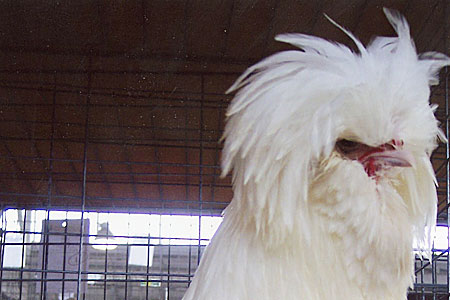
Chicken breeds with beards came about as a genetic mutation. Chicken keepers liked the appearance, and so they continued to breed more of the same. Other than the cuteness factor, scientists have yet to find any significant advantage or disadvantage to a beard on a chicken.
A beard appears as elongated feathers growing beneath a chicken’s beak. A full beard is associated with muffs, or elongated feathers growing outward from the cheeks. Cackle Hatchery® offers the following 10 chicken breeds with beards and muffs:
Ameraucana
The Ameraucana chicken was developed in the United States from blue egg chickens originating in South America. This friendly breed comes in several color varieties, all of which have a beard.
Belgian d’Anvers
The Belgian d’Anvers breed is also variously known as Antwerp Belgian and Bearded d’Anver. This active breed is a true bantam, meaning it has no larger counterpart. It comes in several color varieties, all distinguished by a beard and muffs. The hens lay small eggs with white shells.
Belgian d’Uccle
The Belgian d’Uccle, also called Bearded d’Uccle, was developed by crossing the Belgian d’Anvers with bantam breeds having feathered legs and feet. Like the d’Anvers, it is a true bantam. This breed sports not only a beard, muffs, and leg feathers, but also vulture hocks. The latter consist of long, stiff feathers protruding back from the chicken’s lower thighs.
Crevecoeur
The Crevecoeur, originating in France, has a beard and muffs, and also a crest of head feathers and a V-shape comb. This breed comes in one color — black. The hens are good layers of medium-size eggs with white shells.
Easter Egger
The Easter Egger, like the Ameraucana, originates from South American blue-egg layers. It, too, has a beard and muffs, but is not a standardized breed. It comes in various plumage color patterns, and the hens lay eggs with a variety of shell colors.
Faverolle
The Faverolle, like the Crevecoeur, hails from France. In addition to having a beard and muffs, it has light feathering on the legs and toes, and is one of the few breeds with 5 toes instead of the usual 4. Faverolles are friendly chickens that come in several plumage patterns. The hens lay medium-size eggs with light brown shells.
Houdan
The Houdan was developed from the Crevecoeur, and similarly as a beard, muffs, a crest, and V-shape comb. However, like the Faverolle, it sports 5 toes. The original color is black with blotchy white feathers, although this chicken also comes in a white variety. The hens lay medium-size eggs with white shells.
Polish
The Polish breed has several color patterns that come in varieties either with a beard and muffs or without. Both types have a crest and a V-shape comb. Despite the breed name, they are not really from Poland. The hens are good layers of medium-size eggs with white shells.
Silkie
Silkies, too, can be either bearded or non bearded. This breed has numerous color varieties and several unique features. Its feathers are soft and fur-like. It has black skin, turquoise earlobes, a head crest, and a walnut comb. Like Faverolles, Silkies have 5 toes. The hens lay small eggs with tinted shells. This popular bantam breed is naturally friendly.
Sultan
The Sultan has a beard and muffs, a crest, feathers on the legs and feet, vulture hocks, and 5 toes. Color varieties are pure white, pure black, and blue. The hens lay small eggs with white shells. Sultans are friendly and make excellent pets.
Producing Chicken Breeds with Beards
If you wish to produce quality offspring of a bearded breed, you need to know a bit about the genetics of a beard and muffs. In short, all the offspring will have a full beard and muffs only if both parents are homozygous for the trait. From the time they hatch you can tell whether or not the chicks are bearded.
And that’s today’s news from the Cackle Coop.
Gail Damerow has authored numerous books about poultry, including The Chicken Encyclopedia.

